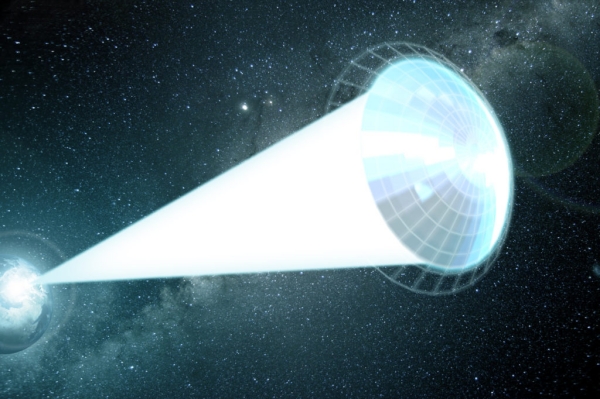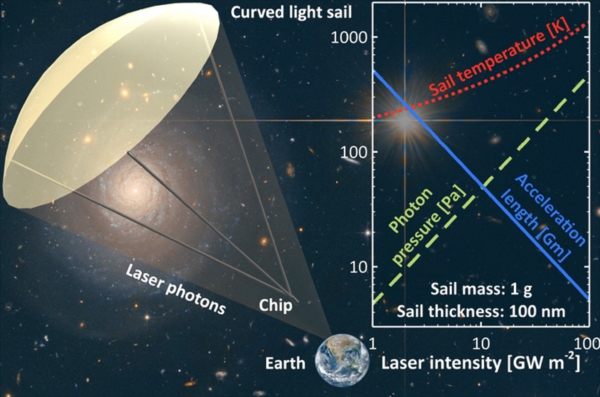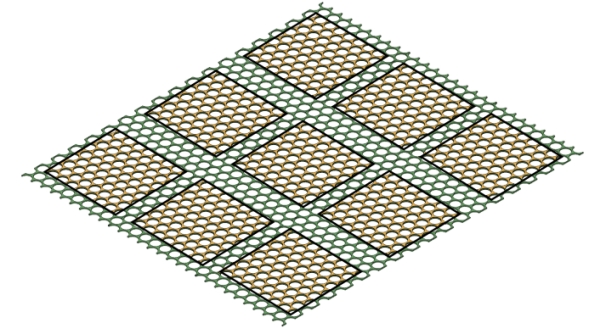One of the benefits of a project like Breakthrough Starshot is that it moves the ball forward in terms of the academic research that underpins advances in technologies. I seriously doubt that Starshot will result in an Alpha Centauri probe reaching these stars within the next 50 years, given among other things the conundrum of data retrieval from a fleet of chip-sized micro-craft. But we all gain from the fact that scientists are tackling these issues in a well-funded and coordinated way. The research library grows.
As a field, interstellar studies has always been resource-starved, not to mention winning scant attention among the larger community of scientists and engineers at conferences and in publications. But it has drawn on a consistent thread of interest that now gains new energies. That benefits the entire effort. And let’s not forget the power of looking far into the future to get a conception of what we can do with scaled-down projects in the near term, as for example Andrew Higgins’ laser-fed fast missions to Mars.
Starshot, of course, takes the laser concept into the interstellar realm, using a massive ground-based array that would likely be based in Chile’s Atacama Desert. The laser array is used to push meter-scale sails, making Starshot’s committee on sail design a major component of the effort. The infusion of funding into sail technologies is welcome, as it leads to new insights into a sail’s shape, its size and its materials.

Image: An artist’s conception of the Starshot Lightsail spacecraft during acceleration by a ground-based laser array. Previous conceptions of lightsails have imagined them being passively pushed by light from the sun, but Starshot’s laser-based approach requires rethinking the sail’s shape and composition so it won’t melt or tear during acceleration. Credit: Masumi Shibata, courtesy of Breakthrough Initiatives.
Thus the significance of Igor Bargatin’s work. An associate professor at the University of Pennsylvania in the Department of Mechanical Engineering and Applied Mechanics, Bargatin and colleagues at the university as well as at UCLA have just published two papers going through fundamental sail issues and specifications. Remember that the projected sails, perhaps three-meters wide and a thousand times thinner than a sheet of paper, are to be subjected to a light intensity millions of times that of the Sun.
The team sees these sails as being made of ultrathin sheets of aluminum oxide and molybdenum disulfide, constructed in a parachute shape rather than a flat surface. The structure would be about as deep as it is wide, allowing the greatest ability under these calculations of withstanding the strain of the sudden acceleration, which is expected to reach tens of thousands of g’s. A ‘billowing’ sail should hold up to the strain better than a tight, flat one, providing a surface that is more resistant to tears.
Matthew Campbell is a postdoctoral researcher in Bargatin’s group and lead author of the paper covering the sail’s shape:
“Laser photons will fill the sail much like air inflates a beach ball. And we know that lightweight, pressurized containers should be spherical or cylindrical to avoid tears and cracks. Think of propane tanks or even fuel tanks on rockets.”

Image: Campbell et al. show that the diameter and radius of curvature of a circular light sail should be comparable in magnitude, both on the order of a few meters, in optimal designs for gram-scale payloads. Credit: Campbell et al.
The second paper, led by UCLA engineer Aaswath Raman, examines sail materials, offering insights into how heat will be dissipated under the powerful laser beam. Here the idea is to use nano-scale patterning within the material to manage the heat. Says Raman:
“If the sails absorb even a tiny fraction of the incident laser light, they’ll heat up to very high temperatures. To make sure they don’t just disintegrate, we need to maximize their ability to radiate their heat away, which is the only mode of heat transfer available in space.”
While earlier research maximized heat dissipation through a photonic crystal design that deployed regularly spaced holes in the sail material, the new work suggests adding a grid-like pattern for the ‘fabric,’ with the spacing of the holes matching the wavelength of light, and the swatches of sail material forming the grid spaced to match the wavelength of the thermal emission. The result is a stronger sail, one that could endure a higher initial thrust and therefore need less time under the beam.
The mathematics involved here is of a complexity far above my pay grade. I’ll have to send you to the paper for the details. But I think we can visualize the sail internals as a kind of ‘scaffolding’ that is apparent in the image below. The reference to ‘Mie resonant features’ in the caption to this image points to the work of Gustav Mie, who described what we now call ‘Mie scattering,’ showing the behavior of light of various wavelengths as it strikes particular kinds of structures. Mie resolved the intricate mathematics of these interactions.

Image: This is Figure S4 from the paper. Caption: Continuous Mie structure design. The black outlines serve to highlight the positions of the Mie resonant features against the continuous reflective green layer, but would not exist in the actual design. Credit: Brewer et al.
UCLA’s Deep Jariwala, who was involved with both papers, comments:
“A few years ago, even thinking or doing theoretical work on this type of concept was considered far-fetched. Now, we not only have a design, but the design is grounded in real materials available in our labs. Our plan for the future would be to make such structures at small scales and test them with high-power lasers.”
Thus the theoretical work continues. Exactly when it pays off in hardware and actual missions is something we cannot know.
The papers are Campbell et al., “Relativistic Light Sails Need to Billow,” Nano Letters 22, 1 (2022), 90-96 (abstract); and Brewer et al., “Multiscale Photonic Emissivity Engineering for Relativistic Lightsail Thermal Regulation,” Nano Letters 22, 2 (2022), 594-601 (abstract).



What I find interesting is teh sail material. At 100nm, it is an order of magnitude thinner than existing metal over polymer solar sails. [Nasa’s upcoming ACS3 solar sail demo has a thickness of a little over 2 um. It will be a CubeSat design and launched by RocketLab in NZ.]
Can this material be adapted to solar sails? It may need a supporting framework to prevent tearing, so perhaps a grid of polymer threads several cm apart, rather like ripstop sail material for boats. While optimized for monochromatic laser light, what is its reflectivity for sunlight? Bear in mind if it had 0% reflectivity and absorbed and radiated the solar energy the acceleration would still be 10x that of existing sail material as the aerial density would be so much lower (excluding the booms).
So as suggested at the beginning of this post, this research might well offer information for solar sail technologies, whether using only sunlight, or given a push with a laser to get the sailcraft moving quickly to escape Earth’s gravity and reduce the slow outward spiral.
Just as JATOs were used to get aircraft off the ground more quickly and reduce runway length, so might lasers of much lesser power than those designed for Breakthrough Starshot or even the LTR, offer sailcraft a boost to start them on their deep space missions. Knowing how those lasers will impact the sail, requiring different or adjustable configurations will be important. I hope this reserach can start to inform the engineers on such advanced sail designs.
While the papers are behind the ACS paywall, there is a wealth of freely available supporting information.
Here be the preprint…
https://arxiv.org/abs/2106.03558
Relativistic light sails need to billow
Multiscale Photonic Emissivity Engineering for Relativistic Lightsail Thermal Regulation
Thanks. I really should get into the habit of looking for pre-prints of journal papers.
Now, this would add mass…but bubble sails with half the interior silvered up? A small floating inner chip could be your feed horn?
I’ve aways been fascinated by Graphene aerogel and wonder if this could help in designing such a sail;
Aerographite: An Advance in Sail Materials with Deep Space Implications.
https://centauri-dreams.org/2020/07/27/aerographite-an-advance-in-sail-materials-with-deep-space-implications/
Could carbon-foam probes bring interstellar flight within reach?
https://centauri-dreams.org/2020/07/27/aerographite-an-advance-in-sail-materials-with-deep-space-implications/
But there is a real major revolution coming in quantum level intereactions between light and matter. This is where the research should be focusing on…
Breakthrough in WARPING Time at Smallest Scale Ever w/ Dr. Jun Ye – matter-energy with timespace interactions become prominent.
Current human events on Planet Earth should make the scientific and technical community more aware that the biggest obstacle to building a working powerful laser that could push an interstellar light sail vessel all the way to Alpha Centauri is politics – which is nothing new.
As I and a few others have asked here before, who is going to fund the construction of this gigalaser? Where is it going to be built? And who is going to ensure it doesn’t get turned into a weapon?
I also need to remind people that Breakthrough Initiative, the biggest supporter of Breakthrough Starshot, is funded by a Russian billionaire. I don’t know about the man personally, but I find it hard to imagine he does not have ties to Putin and other Russian groups that could make the continued support of the gigalaser problematic. Does anyone know anyone else who will then support it financially and such?
I know this is a lot less fun than going over the technical details, but unless it is preferred that interstellar travel remain strictly academic and science fiction, perhaps we need some politically savvy folks to get us through this not minor roadblock on the way to the stars.
They could be good for exploring our star system, too…
https://www.universetoday.com/154668/laser-powered-sails-would-be-great-for-exploring-the-solar-system-too/
Thanks for posting this link. Lubin’s original roadmap suggested that larger probes could be propelled across the solar system at velocities that drastically reduced travel time, yet still allowed the craft to do flybys are velocities that allow good science to be done.
There is certainly a role for low-cost vehicles that can be rapidly propelled to targets in the solar system. By restricting such craft to one or a few relatively simple instruments, they can be rapidly deployed without the years of development of big science probes, as well as completing missions quickly.
But the key is to make these beamed vehicles more flexible in their missions. There is only so much one can do with rapid flybys, even swarms of them. What is needed is a way to decelerate them at their targets so that they can manage to do orbits and even landings. This will require the laser arrays to be present at their destinations. Just as there would eventually be a need for a laser array on Mars to decelerate the LTR craft previously posted on CD, such arrays could also be based in orbit near other popular destinations. If solar-powered, they would best work in the inner system, perhaps out to as far as Jupiter. For destinations further out, these arrays might need batteries to store the weaker solar power or small nuclear power supplies. Because these facilities are large, they would take time to arrive at their destinations to become part of the infrastructure to decelerate beamed light craft. One way to reduce the mass of these systems will be to have them construct their more massive components from space resources at or near their destinations. For example, a laser array might have most of its solar PV arrays manufactured and added on-site, rather than sent from earth, a good example of ISRU. This might work well in the asteroid belt. as well as the Jupiter trojans currently to be visited by the Lucy mission.
There may be other, better solutions to decelerate fast craft, but whatever it is, once we have the infrastructure in place, we can increase the rate of solar system exploration and commerce.
I also think there are network effects to be gained. As more arrays are emplaced, the number of different missions increases as the square of the arrays. Small craft could be bounced from one array to the next, obtaining data and engaging in some forms of commerce. The laser arrays need not just beam power, but could also become high bandwidth communication systems so that images and other dense data could be sent quickly, rather than at relatively slow transmission rates. And of course, they could also do duty in planetary defense, as well as supporting asteroid mining, and powering infrastructure. Once the first is built, there should be cost reduction as the manufacturing experience grows. Ideally, the arrays should be modular so that power can be increased in a modular way, rather than building arrays to custom specifications. A network of arrays would define the specification for laser wavelength[s] so that sails and power conversion kit would be standardized around that wavelength.
It could be a very bright future indeed. (I just hope the astronomers won’t need shades).
Interesting update on Lattice confinement fusion;
NASA’S NEW SHORTCUT TO FUSION POWER
Lattice confinement fusion eliminates massive magnets and powerful lasers.
27 FEB 2022 11 MIN READ
https://spectrum.ieee.org/lattice-confinement-fusion
Nuclear Fusion Reactions in Deuterated Metals.
https://www.youtube.com/watch?v=ug7B7Gsm-2Y&t=13s
The ieee article is interesting. Even though the author says it is not “cold fusion”, the lineage from the early cold fusion devices seems fairly clear. As the author admits, these experiments are a long way from producing net energy and power.
While this is certainly interesting and a new twist on how to achieve fusion power, I don’t think this is going to be the panacea that you actually believe it is going to be. Specifically, there is one glaring problem in this entire set up; if you think about it, you are going to release fusion (i.e. nuclear energy) in a close lattice of essentially a metal hydride which as the reaction proceeds will heat up this hydride to extremely high temperatures.
Guess then what will happen? Undoubtedly the metal lattice will be forced to give up its hydrogen at high temperatures and the reaction will be quenched. That’s why I never had much faith in this even though it is quite exciting in terms of the fundamental physics and technique as to achieve a fairly low temperature fusion source of power. But as a means to achieve rocket propulsion ?! I think that we better go back to the drawing board.
As long as the system generates net power and the total energy produced is greater than chemical fuels, then I see no reason why this low-temperature reactor couldn’t generate the electrical energy for any type of electric propulsion. It doesn’t need to be creating high-temperature plasmas for propulsion.
If it works, a big if, then it would have a role in power generation for a variety of uses, including propulsion.